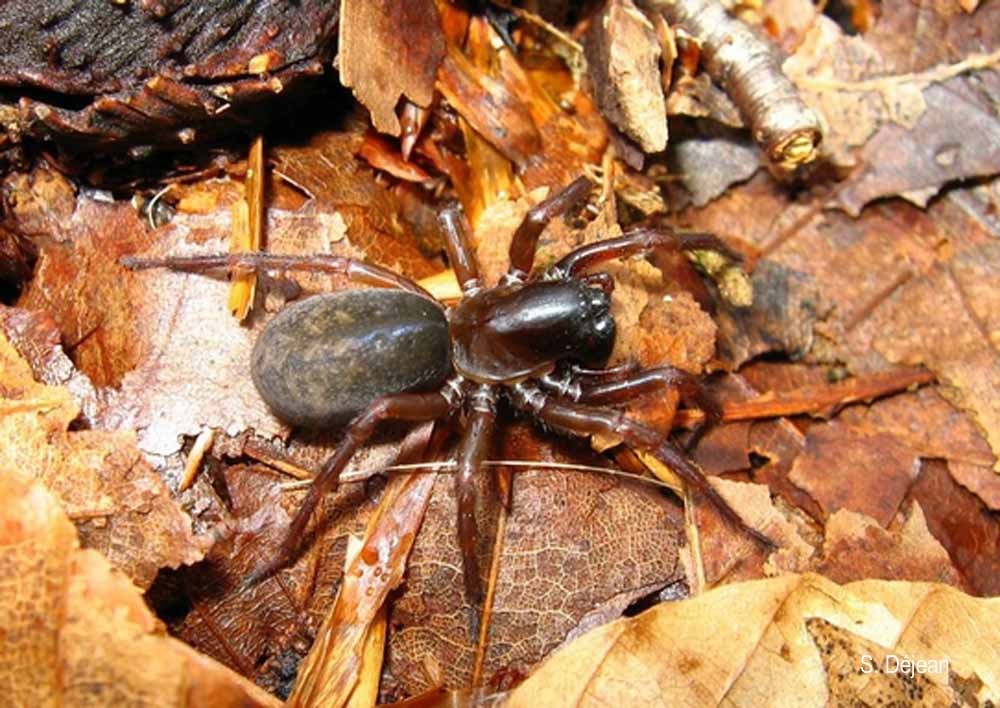
cd_nom

| Author : S. Déjean |
 |
To get the picture, please visit:
Sylvain Déjean
Biodiversité et gestion des territoires
Université de Rennes 1
SPN, Av du Gal leclerc
30042 Rennes Cedex
email: alain.canard@univ-rennes1.fr
Legend: Canroute bis
Any reuse of one or more photographs on this site is subject to an authorization request from the author.
Link to the Code of Intellectual Property (Legifrance)

| Author : S. Déjean |
 |
To get the picture, please visit:
Despite the Creative Commons license, please inform the author of the use which will be made of his photo
Distribution mondiale
Europe moyenne (manquant au Nord et au Sud)
Caractères distinctifs, espèces
Taille - femelle : 10-14 mm, mâle : 8-10 mm.
L'espèce présente des pattes et un céphalothorax brun foncé avec un abdomen noir velouté avec des taches en chevron plus claires. Elle a le même aspect qu'un Amaurobius mais ses filières antérieures sont développées et ne sont pas des plaques (cribellum). On compte 7 espèces dans le genre Coelotes en France, et trois autres dans des genres très proches (Inermocoelotes et Pyreneteiga). L'observation des pièces génitales est indispensable pour identifier les espèces.
Milieux colonisés
L'espèce colonise les pierres, les souches et la litière en forêt. On la trouve aussi dans des steppes, des landes peu ensoleillées (exemple : Mont d'Arrée en Bretagne).
Chasse
L'espèce tisse une toile très peu étendue, de quelques centimètres, en prolongement d'une longue retraite en tube qui se développe au sol sous une pierre, une branche ou dans la végétation. Il est actif la nuit et capture de nombreux coléoptères, cloportes ou mille-pattes. Les proies qui s'aventurent le long de la toile sont mordues puis entraînées dans la retraite.
Développement, cycle
Les adultes mâles sont présents en fin d'été, les femelles du printemps à l'automne. Le cycle semble annuel.
La femelle élargit sa retraite au moment de la période de ponte en juin-juillet, c'est dans un espace étendu qu'elle dépose son cocon, contenant 40 à 60 œufs, et qu'elle reste avec sa progéniture. Après l'éclosion et la sortie des jeunes du cocon, la femelle capture des proies qu'elle régurgite à ses jeunes ou qu'elle met à leur disposition. Ceux-ci chassent ensuite dans le nid et en développent la construction. La femelle meurt aux premiers froids de l'hiver et est dévorée par sa progéniture qui reste dans le nid et ne se dispersera qu'après la fin de l'hiver.
A. Canard(Université de Rennes/Service du Patrimoine Naturel, MNHN),2014
Continental
Metropolitan France
Overseas
Marine
Metropolitan France
Overseas
The map presents a summary at the 10 x 10 km grid of the observation data for the species transmitted to the SINP. These data have been subjected to validation filters.
The map presents a reference distribution layer of the species at the scale of departments and marine sectors. The presence and absence data were established by expertise within a network of partners. This reference distribution is used in the validation process of the SINP data at the INPN level.
Corresponds to a report on the basis of at least one observation proved within a period of 10 years (20 years for little-known invertebrates) preceding the year and no presumption of extinction since obtaining the last data nor doubt on reproductive and implemented nature of this population. For migratory species, the presence indicated concerns areas of reproduction.
This status is based on one or more of the following criteria:
This point covers the absence, more difficult by nature to demonstrate than presence. This status is based on one or more of the following criteria:
This status must be assigned to a department in which the presence of the species is casual.
Particular case of absence due to a proven extinction less than a half century ago (older disappearances are treated as "no probable or definite").
In the state of knowledge, we can not comment on the presence or absence in the current department. This is the default status when not comprised in one of the previous categories or whenever there is doubt.
The map shows the global distribution of the species based on GBIF data (Global Biodiversity Information Facility).
